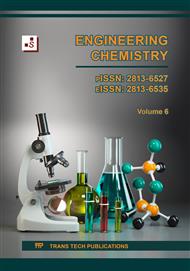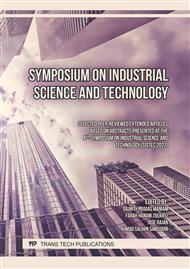[1]
K.S Chandan, K Savita and R Sashwati. Tocotrienols: Vitamin E beyond tocopherols. Life Sciences,78 (2006) 2088–2098.
DOI: 10.1016/j.lfs.2005.12.001
Google Scholar
[2]
J.Y Fu, H.L Che, D.M.Y Tan and K.M Teng. Bioavailability of tocotrienols: evidence in human studies. Nutrition & Metabolism,11 (2014) 5.
DOI: 10.1186/1743-7075-11-5
Google Scholar
[3]
What is tocotrienol on https://www.verywellhealth.com/tocotrienol-5093146#toc-dosage-and-preparation
Google Scholar
[4]
N. Dasgupta and S. Ranjan. Fabrication of Nanoemulsion: A Brief Review in: An Introduction to Food Grade Nanoemulsions. Springer, (2018) 49-62.
DOI: 10.1007/978-981-10-6986-4_3
Google Scholar
[5]
N. Wilson and N.P Shah. Microencapsulation of vitamins. ASEAN Food Journal 14 (1), (2007) 1-14.
Google Scholar
[6]
H. Korhonen. Technology options for new nutritional concepts. International Journal of Dairy Technology 55 (2), (2002) 79-88.
DOI: 10.1046/j.1471-0307.2002.00050.x
Google Scholar
[7]
C.C Chen and G. Wagner. Vitamin E nanoparticle for beverage applications. Chemical Engineering Research and Design 82(11), (2004) 1432-1437.
DOI: 10.1205/cerd.82.11.1432.52034
Google Scholar
[8]
P.S Goh, M.H Ng, Y.M Choo, B.A Nasrulhaq and C.H Chuah. Production of tocols nanoemulsion by ultrasonication. Journal of Oil Palm Research 28(1), (2016) 121-130.
DOI: 10.21894/jopr.2016.2801.14
Google Scholar
[9]
Y.M Choo, L.L.N Harrison, C.W Puah, M.H Ng, S.C Bong, A.N Ma and Y. Basiron. Production of phytonutrients (carotenes, vitamin E, sterols, squalene, co-enzyme q and phospholipids) from palm methyl esters. In: MPOB Transfer of Technology, 2002 MPOB Information Series No. 151.
Google Scholar
[10]
P.T Voon, W.T Lai, M.S Miskandar, W.H Lim, O.M Lai and C.P Tan. Nutramee – A lipophilic antioxidant noodle. In: MPOB Transfer of Technology, 2014, MPOB Information Series No. 563.
Google Scholar
[11]
K. Nesaretnam, K.R Selvaduray, W.H Lim and A.R Ghazali. A transdermal tocotrienol breast cream. In: MPOB Transfer of Technology, 2007, MPOB Information Series No. 378.
Google Scholar
[12]
I. Zahariah, A. Salmiah, I. Rosnah, A. Zafarizal and T.L Ooi. palm-based skin care and colour cosmetic products. In: MPOB Transfer of Technology, 2005, MPOB Information Series No. 273-274.
Google Scholar
[13]
H.N Sook, M.W Pei, B. Mahiran and I. Zahariah. Characterization of structural stability of palm oil esters-based nano cosmeceuticals loaded with tocotrienol. Journal of Nanobiotechnology 11(27), (2013)1477-3155.
DOI: 10.1186/1477-3155-11-27
Google Scholar
[14]
Natural source vitamin E (tocopherols and tocotrienols) – A global market overview on https://www.researchandmarkets.com/reports/4749730/natural-source-vitamin-e tocopherols-and#src-pos-1
DOI: 10.1201/9781420080391-12
Google Scholar
[15]
I. Siro´, E. Ka´Polna, B. Ka´Polna and A. Lugasi. Functional food. Product development, marketing and consumer acceptance - A review. Appetite 51 (2008) 456-467.
DOI: 10.1016/j.appet.2008.05.060
Google Scholar
[16]
M.C Kristi and F. Coni. Position of the academy of nutrition and dietetics: Functional foods. Journal of the academy of nutrition and dietetics 113, (2013)1096-1103.
DOI: 10.1016/j.jand.2013.06.002
Google Scholar
[17]
A.H Saberi, Y. Fang and D.J Mcclements. Fabrication of vitamin E – enriched nanoemulsions: Factors affecting particle size using spontaneous emulsification. Journal of Colloid and Interface Science 391, (2013) 95-102.
DOI: 10.1016/j.jcis.2012.08.069
Google Scholar
[18]
S.M Jafari, Y He and B Bhandari. Production of sub-micron emulsions by ultrasound and microfluidization techniques. J. Food Engineering 82, (2007) 478-488.
DOI: 10.1016/j.jfoodeng.2007.03.007
Google Scholar
[19]
Y. Yang and D.J McClements. Encapsulation of vitamin E in edible emulsions fabricated using a natural surfactant. Food Hydrocolloids 30, (2013) 712-720.
DOI: 10.1016/j.foodhyd.2012.09.003
Google Scholar
[20]
A.H Saberi, Y. Fang and D.J Mcclements. Stabilization of vitamin E-enriched mini-emulsions: Influence of organic and aqueous phase compositions. Colloids and Surfaces A: Physochemical and Engineering Aspects 449, (2014) 65-73.
DOI: 10.1016/j.colsurfa.2014.02.042
Google Scholar



